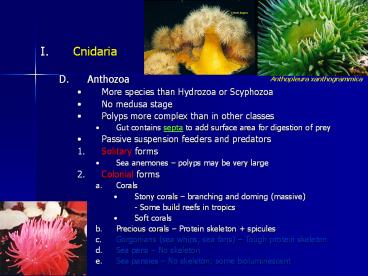Cnidaria - PowerPoint PPT Presentation
Title:
Cnidaria
Description:
Cnidaria Anthozoa More species than Hydrozoa or Scyphozoa No medusa stage Polyps more complex than in other classes Gut contains septa to add surface area for ... – PowerPoint PPT presentation
Number of Views:77
Avg rating:3.0/5.0
Title: Cnidaria
1
- Cnidaria
- Anthozoa
- More species than Hydrozoa or Scyphozoa
- No medusa stage
- Polyps more complex than in other classes
- Gut contains septa to add surface area for
digestion of prey - Passive suspension feeders and predators
- Solitary forms
- Sea anemones polyps may be very large
- Colonial forms
- Corals
- Stony corals branching and doming (massive)
- - Some build reefs in tropics
- Soft corals
- Precious corals Protein skeleton spicules
- Gorgonians (sea whips, sea fans) Tough protein
skeleton - Sea pens No skeleton
- Sea pansies No skeleton some bioluminescent
Anthopleura xanthogrammica
2
Branching Corals
Doming Corals
3
Soft Corals
Precious Corals
4
- Cnidaria
- Anthozoa
- More species than Hydrozoa or Scyphozoa
- No medusa stage
- Polyps more complex than in other classes
- Gut contains septa to add surface area for
digestion of prey - Passive suspension feeders and predatorsolitary
forms - Sea anemones polyps may be very large
- Colonial forms
- Corals
- Stony corals branching and doming (massive)
- - Some build reefs in tropics
- Soft corals
- Precious corals Protein skeleton spicules
- Gorgonians (sea whips, sea fans) Tough protein
skeleton - Sea pens No skeleton
- Sea pansies No skeleton some bioluminescent
Anthopleura xanthogrammica
5
Gorgonians (Sea Whips)
6
Gorgonians (Sea Fans)
7
- Cnidaria
- Anthozoa
- More species than Hydrozoa or Scyphozoa
- No medusa stage
- Polyps more complex than in other classes
- Gut contains septa to add surface area for
digestion of prey - Passive suspension feeders and predators
- Solitary forms
- Sea anemones polyps may be very large
- Colonial forms
- Corals
- Stony corals branching and doming (massive)
- - Some build reefs in tropics
- Soft corals
- Precious corals Protein skeleton spicules
- Gorgonians (sea whips, sea fans) Tough protein
skeleton - Sea pens No skeleton
- Sea pansies No skeleton some bioluminescent
Anthopleura xanthogrammica
8
Sea Pens
9
- Cnidaria
- Anthozoa
- More species than Hydrozoa or Scyphozoa
- No medusa stage
- Polyps more complex than in other classes
- Gut contains septa to add surface area for
digestion of prey - Passive suspension feeders and predators
- Solitary forms
- Sea anemones polyps may be very large
- Colonial forms
- Corals
- Stony corals branching and doming (massive)
- - Some build reefs in tropics
- Soft corals
- Precious corals Protein skeleton spicules
- Gorgonians (sea whips, sea fans) Tough protein
skeleton - Sea pens No skeleton
- Sea pansies No skeleton some bioluminescent
Anthopleura xanthogrammica
10
Sea Pansies
11
- Cnidaria
- Cubozoa
- Sea wasps, Box jellyfish
- Small medusae
- Life cycles poorly known include polyp stage
- Highly toxic
- Eat fishes, worms, arthropods
12
(No Transcript)
13
- Ctenophora
- Comb jellies
- Exclusively marine (100 species)
- Radial symmetry
- Eight rows of ciliary combs
- Used for swimming video
- Carnivorous
- Lack nematocysts
- Capture prey with sticky colloblasts
- May occur in swarms
- Heavy predators on plankton, including fish
larvae - Body forms
- Tentaculate Planktivores
- Lobate - Ctenophorivores
14
(No Transcript)
15
- Ctenophora
- Comb jellies
- Exclusively marine (100 species)
- Radial symmetry
- Eight rows of ciliary combs
- Used for swimming
- Carnivorous
- Lack nematocysts
- Capture prey with sticky colloblasts
- May occur in swarms
- Heavy predators on plankton, including fish
larvae - Body forms
- Tentaculate Planktivores
- Lobate - Ctenophorivores
16
Pleurobrachia
Tentaculate
Beroe
Lobate
17
- Worms
- Body shape very common in invertebrates
- Especially in mobile invertebrates
- Flexibility
- Maneuverability
- Bilateral Symmetry
- Cephalization
- Head end with
- Accumulation of nerve tissue (brain)
- Sensory structures
- Anterior Posterior
- Dorsal - Ventral
- Left - Right
18
Fig. 7.12
19
- Platyhelminthes
- Flatworms - Dorsoventrally flattened
- Simplest bilaterally symmetrical organisms
- First organs and organ systems
- Central nervous system
- Simple brain coordinates muscle movements
- Incomplete digestive system
- Mouth but no anus
- Similar to Cnidaria and Ctenophora
- Mesoderm
- Cell layer between endoderm and ectoderm
- Gives rise to muscles, reproductive system
20
- Platyhelminthes
- Turbellaria
- Mostly free-living carnivorous species
- Most commonly seen (Why?)
- Some live as commensal animals inside other
invertebrates (oysters, crabs, etc.)
21
(No Transcript)
22
- Platyhelminthes
- Trematoda (Flukes)
- Most species (6000)
- Parasitic Feed on tissues, blood, gut contents
- Complex life cycles
- Adults live in vertebrate host (fish, whale,
bird) - Larvae may inhabit invertebrates (intermediate
hosts) - Vertebrate eats intermediate host (clam, snail,
etc.) - Cestoda (Tapeworms)
- Parasitic
- Live in vertebrate intestines
- Head attaches to intestine wall with suckers or
hooks - Gutless absorb nutrients through body wall
- May reach 50 feet!! (sperm whales)
23
- Nemertea
- Ribbon worms
- Cosmopolitan
- Most common in shallow, temperate regions
- Complete digestive tract
- Mouth and anus
- Circulatory system
- Use long, fleshy proboscis to capture prey
- Feed on crustaceans and worms
- May be cryptic or conspicuous
- Can reach 30 m in length!!































